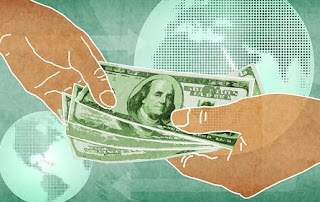
I have recently stumbled upon a CNNMoney article on microfinance that talks about SKS Microfinance Ltd., India's biggest microlender', debut on Bombay Stock Exchange.
At first, I saw no problem with SKS' Initial Public Offering (IPO). By going public SKS will attract more money to its business that means more loans for India's poor. Yet, I forgot that as a public company SKS now will be accountable to its shareholders, who are interested in profit-maximization, not in serving the poor. How does a microfinance organization boosts its profits? You got it - by increasing interest rates on its loans. Now, this, of course, has been the main criticism of the founder of microfinance, Muhammad Yunus. He affirms that any microcredit organization charging its clients more than 15% interest rate does not truly serve the poor, rather it is in a profit-maximizing business.

So, is there a way for MFIs to get investment without raising their interest rates? The answer, yet again, lays in creative and unconventional thinking of Muhammad Yunus. The answer is social business, a business that functions in every way as a regular profit-maximizing enterprise except that it is not. Instead of profit maximization a social business' only goal is to serve a cause. Thus, a social business uses all its profits solely for the expansion of its operations. Moreover, a social business can be social in a different way, having poor people as its shareholders. In the beginning though social business has to be supported by regular investors, who will put their capital into a social business as into any other one, the only difference being that they will not receive any dividends. As soon as a social business becomes self-sustainable, investors will get their money back and will be able to decide to reinvest the sum or spend it on something else. The motivation behind investing in social businesses is simple: the desire to do good, which is in human nature and which brings if not material then emotional and spiritual benefits.
Therefore, only if SKS was operating as a social business and if its shareholders had altruistic and idealistic minds, then SKS could have continued to truly serve the poor at the same time getting enough investments to run its business and expand its operations. Yet, in the business of serving the poor there is no place for self-enrichment. That again proves Muhammad Yunus' position, arguing that any hybrid business model will ultimately sacrifice its altruistic values for profit maximization.
And yes, did I mention that Vikram Akula, the founder of CEO of SKS, has recently sold his shares of the company for $10 million? He says he is not ashamed of it, stating that rewarding microfinance employees is part of his business strategy. That's a nice reward, isn't it? Especially that much of SKS' original capital came from public donations and grants.
Now, where do you stand on this issues? Do you sympathize with Mr. Akula's strategy or admire Mr. Yunus' altruistic position? If you haven't made up your mind yet, you will probably be able to do so after watching Muhammad Yunus' and Vikram Akula's debate on September 21st at the Clinton Global Initiative.

